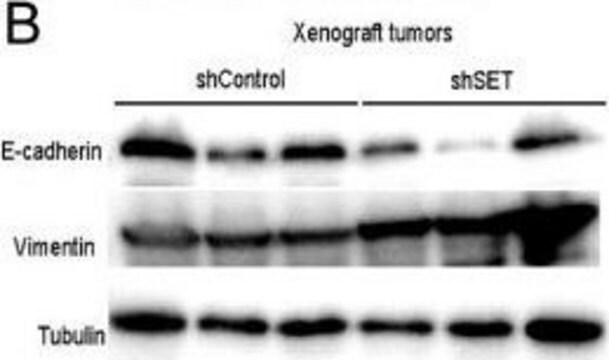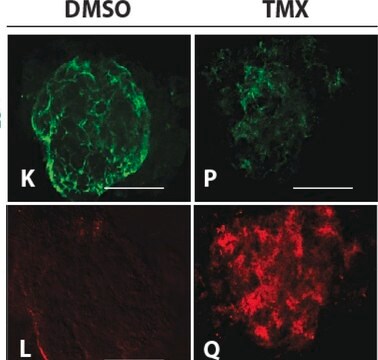Kluczowe dokumenty
C9080
Monoclonal Anti-Vimentin−Cy3 antibody produced in mouse
clone V9, purified immunoglobulin, buffered aqueous solution
Synonim(y):
Monoclonal Anti-Vimentin
Wybierz wielkość
2180,00 zł
Wybierz wielkość
About This Item
2180,00 zł
Polecane produkty
pochodzenie biologiczne
mouse
białko sprzężone
CY3 conjugate
forma przeciwciała
purified immunoglobulin
rodzaj przeciwciała
primary antibodies
klon
V9, monoclonal
Formularz
buffered aqueous solution
masa cząsteczkowa
antigen ~58 kDa
reaktywność gatunkowa
pig, canine, feline, hamster, rabbit, gerbil, monkey, bovine, chicken, human, horse, rat
metody
direct immunofluorescence: 1:200 using cultured cells
immunohistochemistry (formalin-fixed, paraffin-embedded sections): 1:50 using human tonsil
immunohistochemistry (frozen sections): suitable using human tonsil
izotyp
IgG1
numer dostępu UniProt
Warunki transportu
wet ice
temp. przechowywania
2-8°C
docelowa modyfikacja potranslacyjna
unmodified
informacje o genach
human ... VIM(7431)
rat ... Vim(81818)
Szukasz podobnych produktów? Odwiedź Przewodnik dotyczący porównywania produktów
Opis ogólny
Specyficzność
Immunogen
Zastosowanie
- immunofluorescence and confocal microscopy
- cytoskeleton staining
- double labeling experiments
- immunohistochemical
- immunocytochemical localozation
Działania biochem./fizjol.
Postać fizyczna
Przechowywanie i stabilność
Informacje prawne
Oświadczenie o zrzeczeniu się odpowiedzialności
Nie możesz znaleźć właściwego produktu?
Wypróbuj nasz Narzędzie selektora produktów.
Kod klasy składowania
10 - Combustible liquids
Klasa zagrożenia wodnego (WGK)
nwg
Temperatura zapłonu (°F)
Not applicable
Temperatura zapłonu (°C)
Not applicable
Środki ochrony indywidualnej
Eyeshields, Gloves, multi-purpose combination respirator cartridge (US)
Wybierz jedną z najnowszych wersji:
Certyfikaty analizy (CoA)
Nie widzisz odpowiedniej wersji?
Jeśli potrzebujesz konkretnej wersji, możesz wyszukać konkretny certyfikat według numeru partii lub serii.
Masz już ten produkt?
Dokumenty związane z niedawno zakupionymi produktami zostały zamieszczone w Bibliotece dokumentów.
Klienci oglądali również te produkty
Active Filters
Nasz zespół naukowców ma doświadczenie we wszystkich obszarach badań, w tym w naukach przyrodniczych, materiałoznawstwie, syntezie chemicznej, chromatografii, analityce i wielu innych dziedzinach.
Skontaktuj się z zespołem ds. pomocy technicznej









